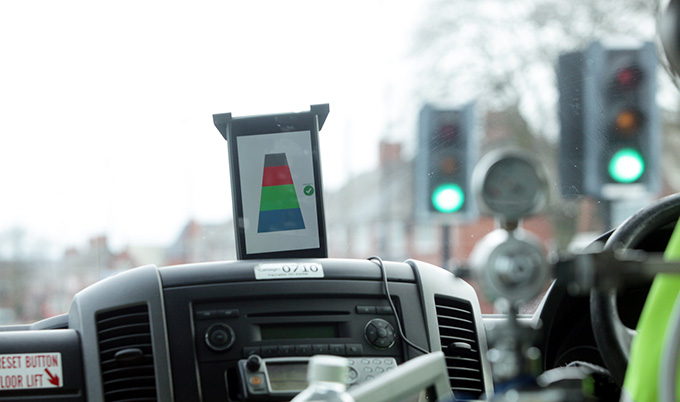Compass 4 D extension
Newcastle’s ‘talking’ traffic lights could cut congestion
Published on: 24 November 2015
A ground-breaking project in Newcastle piloting technology where traffic lights ‘talk’ to motorists could be rolled out to tackle congestion and pollution in major cities across Europe.
Real life deployment
Newcastle is one of seven European pilot sites trialing the new technology of communicating vehicles as part of the 10m Euro Compass4D project funded by the European Union.
The project, running in the east end of Newcastle in specially equipped NHS and electric vehicles linked to technology at 20 road junctions, is being closely watched by authorities in Barcelona and Amsterdam keen to see if it could help cut their traffic snarl ups.
It comes as the project moves from EU funding to a public-private partnership for a year and as leading figures from the project partners meet at a conference in Newcastle this week to discuss its impact to date.
Giacomo Somma, the European Project co-ordinator of Compass 4D said: “Continuing with a public-private partnership without funding from the European Union is a unique decision which demonstrates the strong engagement of all stakeholders along the whole value chain as well as their trust in the role of cooperative ITS services to achieve strategic targets of safer and cleaner mobility and impact the road transport market.”
It means that the system will operate in real traffic environments and partners will gain insights into the sustainable deployment of the cooperative systems and services.

Improved experience
The UK arm of the project involves linking an in-vehicle communication system directly with Newcastle’s Urban Traffic Management Control (UTMC) centre - the infrastructure ‘talking’ to motorists, giving certain vehicles priority at junctions.
The personalised communication system warns drivers of obstacles on the road, gives key road users such as NHS vehicles priority at lights and helps drivers adjust their speed so they can pass through a series of lights on green.
Led by Newcastle University in collaboration with Newcastle City Council, Siemens and the North East Ambulance Service, the project’s aim has been to improve safety, cut patient journey times, and reduce congestion and pollution by helping motorists to drive more efficiently.
The system has been fitted in trials to 11 non-emergency North East Ambulance Patient Transport Service (PTS) vehicles based at the Freeman Hospital. Its aim is to create a smoother journey for patients, while at the same time helping to cut the trust’s fuel bill.
Its PTS vehicles are used to take patients to and from hospital appointments, such as for dialysis and cancer treatment
Paul Liversidge, NEAS Chief Operating Officer, said: “As the region’s only public sector ambulance service, improving the experience people have on board our vehicles is at the heart of what we do.
"Trialling technology like this in a real setting gives a more valuable understanding of how it could add more value to ambulance services throughout the UK and we are pleased to be part of the project.”
Two Newcastle University electric vehicles are also part of the trial which has been running for a year.
A trailblazer for the UK
Newcastle University Senior Research Associate Simon Edwards said: “Newcastle is a trailblazer for the UK, a test bed for this technology to be rolled out. We are collating data which focuses on the impact of this technology on traffic pollution levels and energy savings, which is data local authorities and governments are really keen to have.
“This isn’t lab work – this is working on real roads in real traffic conditions during everyday travel and weather with all that brings to the roads network.
“The technology encourages drivers to drive more efficiently by giving them more advice in their vehicle about how to drive and hit a green light for example, meaning they aren’t stop-starting at traffic lights and aren’t burning as much fuel.”
In Newcastle, the project is centred on traffic lights at Benton Road, Chillingham Road and the Corner House to Newcastle Civic Centre via Sandyford Road.
Ray King, Newcastle UTMC manager, said: “This extension of the project shows the commitment by all partners to this technology due to its success. All seven cities, including Newcastle, have ambitious plans to extend the technology to further areas and develop additional uses.
“In addition to the existing deployment sites, other European cities such as Amsterdam and Barcelona are also keen to learn from our experience and implement similar technologies.”
In the Netherlands, the urban pilot of Helmond is ready to be extended to a regional corridor taking in the cities of Eindhoven and Tilburg.
The project will play a key role in developing Newcastle as a smart city of the future and an exemplar of sustainability, building on Newcastle University’s world class research in urban sciences.
All of the project partners have agreed to continue to support the deployed assets for at least another 12 months, with all costs being covered by the partners as of January 2016.
Compass4D is a project involving seven European cities - Bordeaux, France; Copenhagen, Denmark; Helmond, Netherlands; Thessaloniki, Greece; Verona, Italy; Vigo, Spain; and Newcastle, United Kingdom.
It is co-ordinated by the European Road Transport Telematics Implementation Coordination Organisation (ERTICO – ITS Europe), a partnership of more than 100 public and private organisations concretely engaged with the deployment of Intelligent Transport Systems and Services (ITS).
The project continuing to operate in real-time traffic environments will give the wider ITS community the valuable insight and knowledge needed to help deploy intelligent traffic systems more widely.



